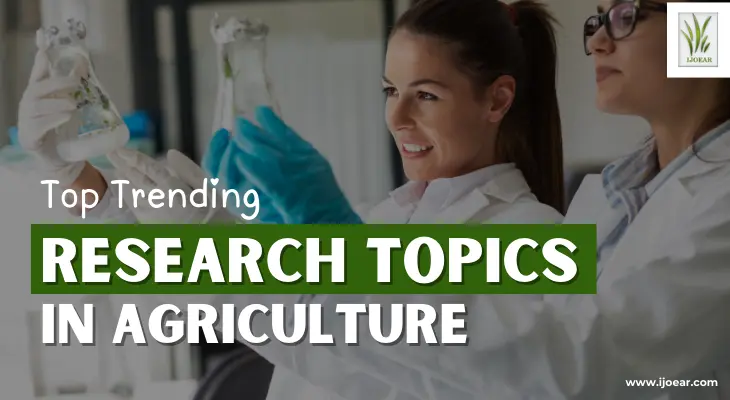
Agriculture is evolving rapidly with technological advancements, sustainability concerns, and the need for higher productivity. Researchers worldwide are focusing on innovative approaches to improve crop yield, soil health, and resource efficiency. Below are some of the top trending research topics in agriculture that are shaping the future of food production and environmental sustainability.
Precision agriculture utilizes advanced technologies like GPS, IoT sensors, AI, and drones to optimize farming practices. Researchers are exploring ways to improve real-time monitoring, automated irrigation, and site-specific crop management to enhance productivity while minimizing resource wastage.
Read More: Precision Agriculture: Maximizing Efficiency and Minimizing Waste
With climate change threatening food security, scientists are developing drought-resistant, flood-tolerant, and heat-resistant crops through genetic modification and selective breeding. This research ensures stable crop production in extreme weather conditions.
Read More: Climate-Resilient Crops: Ensuring Food Security in a Changing Climate
The rising global population and decreasing arable land have led to innovative farming solutions like vertical farming and hydroponics. Researchers are focusing on sustainable urban agriculture to produce fresh food locally, reducing dependence on traditional farmland.
Read More: Vertical and Urban Farming: The Future of Sustainable Agriculture
Soil degradation is a critical issue, prompting research into regenerative farming practices such as cover cropping, no-till farming, and organic composting. These methods help restore soil fertility, increase microbial activity, and enhance carbon sequestration.
Read More: Regenerative Agriculture: Increasing Farm Resilience and Profitability
Integrated pest management (IPM) strategies, including biopesticides, beneficial insects, and AI-driven early detection systems, are being developed to reduce dependency on chemical pesticides and minimize environmental impact.
Read More: Sustainable Pest and Disease Management
Advances in biotechnology, such as CRISPR gene editing, are enabling scientists to enhance crop resistance, improve nutritional content, and develop biofortified crops that combat malnutrition worldwide.
Read More: Agri-Biotechnology and Genetic Engineering
With the growing demand for sustainable protein sources, research is expanding into plant-based proteins, lab-grown meat, and insect farming. These innovations offer solutions to food security and environmental challenges.
Efficient water use is critical in agriculture. Research is focused on developing smart irrigation techniques, water recycling, and drought-resistant crop varieties to reduce water consumption in farming.
Read More: Water Conservation and Smart Irrigation Systems
Technology-driven innovations such as blockchain for supply chain transparency and AI-powered predictive analytics are transforming agriculture by improving traceability, reducing food fraud, and optimizing farm operations.
Read More: Blockchain and AI in Agriculture: Transforming the Future of Farming
With increasing global concerns over carbon emissions, carbon farming practices and agroforestry research aim to promote sustainable land management while enhancing biodiversity and mitigating climate change.
Read More: Carbon Farming and Agroforestry Research: A Sustainable Solution for Climate Change
The International Journal of Environmental and Agriculture Research (IJOEAR) serves as a valuable platform for publishing high-quality research in agriculture. Our peer-reviewed journal provides global visibility for your work, ensuring it reaches researchers, academicians, and policymakers. We offer:
Publishing with IJOEAR helps researchers contribute to advancements in agriculture while gaining global recognition for their work.
The agricultural sector is undergoing a transformation driven by sustainability and technology. Research in these trending areas is essential for ensuring food security, environmental conservation, and improved farm productivity. As new advancements continue to emerge, staying updated on these topics will be crucial for farmers, scientists, and policymakers alike.
1. What are the current trending research areas in agriculture?
Trending topics include precision farming, climate-resilient crops, vertical farming, agri-biotechnology, sustainable pest management, regenerative agriculture, and AI-based agricultural forecasting.
2. Why is precision agriculture gaining attention?
Precision agriculture uses GPS, IoT, drones, and data analytics to optimize input use (like water, fertilizers), improving productivity while reducing environmental impact and cost.
3. What role does biotechnology play in modern agricultural research?
Agri-biotechnology focuses on improving crop yield, pest resistance, nutritional content, and environmental tolerance using tools like genetic engineering and CRISPR gene editing.
4. How is climate change influencing agricultural research?
Researchers are exploring heat- and drought-tolerant crop varieties, water-saving irrigation methods, and adaptive farming practices to help agriculture cope with changing weather patterns.
5. What is the significance of vertical and urban farming in research?
As urban populations grow, vertical farming offers sustainable food production solutions with minimal land use, controlled environments, and year-round yields.
6. Are sustainable practices a major focus in agricultural research?
Yes. Topics like organic farming, integrated pest management, soil regeneration, and reduced chemical input are key to ensuring long-term agricultural sustainability.
7. How is artificial intelligence being used in agricultural research?
AI is used in crop disease prediction, yield forecasting, smart irrigation, and automating labor-intensive tasks, making farming more efficient and data-driven.
8. What are researchers doing to improve food security through agriculture?
Research is focused on improving crop resilience, reducing post-harvest losses, enhancing supply chains, and developing crops with better nutritional profiles.
 NAAS Rating: 4.23
NAAS Rating: 4.23  October 2025 Issue
October 2025 Issue  Impact Factor: 6.69
Impact Factor: 6.69  Submit Article
Submit Article 
|
Citation Indices
|
All
|
Since 2020
|
|
Citation
|
6164
|
5117
|
|
h-index
|
31
|
29
|
|
i10-index
|
201
|
165
|
|
Acceptance Rate (By Year)
|
|
|
Year
|
Percentage
|
|
2024
|
11.09%
|
|
2023
|
15.23%
|
|
2022
|
12.81%
|
|
2021
|
10.45%
|
|
2020
|
9.6%
|
|
2019
|
14.3%
|
|
2018
|
17.65%
|
|
2017
|
16.9%
|
|
2016
|
22.9%
|
|
2015
|
26.1%
|